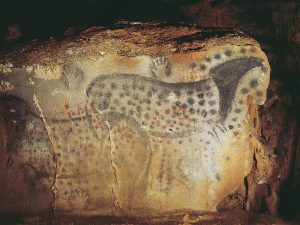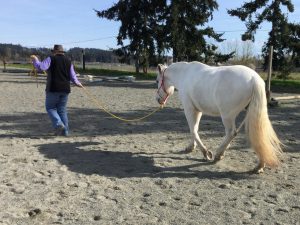Fran writes,”I’ve never spent time with horses except for a scary trail riding day as a child. I recently spent two afternoons learning about mindfulness and equine-facilitated wellness. I was curious, a little anxious, but not afraid, especially of gentle Dante, but wary of Hero, his much bigger paddock mate.”
 The pre-historic cave paintings in Pech-Merle (France) indicate that early mankind revered horses and believed them to possess magical healing powers. Because of their long affinity with humans this has resulted in a special relationship with the horse that has archetypal and healing significance (Burgon, 2013).
The pre-historic cave paintings in Pech-Merle (France) indicate that early mankind revered horses and believed them to possess magical healing powers. Because of their long affinity with humans this has resulted in a special relationship with the horse that has archetypal and healing significance (Burgon, 2013).
“When we arrived we stood for a while watching the horses in their paddocks. Country quiet, ravens calling, wind in trees, smell of horses, hay, manure, grass. Peter talked of their body language, how they interact: ears forward or back, where their attention rests, often one alert with head up while others eat or rest, how the dominant horse moves the others off the best hay pile, how Dante yields to big Hero, but swishes his tail and turns his head, showing he could kick if he wanted.”
Claims for the benefit of being in the natural environment are wide ranging, from its spiritual, aesthetic, and physical realms, to the more recent fields known as nature therapy, eco-therapy and eco-psychology (Rozak, 1995).
“On the first day, Peter showed me how to hold the rope loosely, ready to tighten or loosen as needed. We walked three abreast so I could see how Dante responded to Peter’s directions, without pulling on the halter at all. That day I felt uneasy, overwhelmed by so much newness, found it difficult to be present, to focus on Peter and Dante and myself all at the same time, to anticipate turn and stop signals. I wanted so much to learn what Peter was showing me, but felt awkward and doubted that I could.
“the second day began more slowly, taking time to be present, feeling feet on the ground, connecting with myself and the horse. I was much more at ease, more comfortable with Dante and able to talk about any awkwardness I felt. At the exercise field, Peter reminded me how to hold the rope loosely then handed me Dante’s lead and sent us off walking shoulder to shoulder, straight ahead, turning left, turning right, stopping, stepping over some logs, all with the rope hanging loose. Dante followed my movements, gently, patiently.
And I had it! All the talk of being grounded and present, and being with this horse – there it was!”
 Horses live in the present moment, highly aware of their surroundings, without the ability to ruminate about the past or worry about the future. They fully use all of their senses, including their ability to read the inner state of another. They are social and respond warmly to humans who are in touch with their emotions. Their attentiveness to the present state of a human has the capacity to heal old wounds through the bond of connection in the here and now (Marshall, 2014).
Horses live in the present moment, highly aware of their surroundings, without the ability to ruminate about the past or worry about the future. They fully use all of their senses, including their ability to read the inner state of another. They are social and respond warmly to humans who are in touch with their emotions. Their attentiveness to the present state of a human has the capacity to heal old wounds through the bond of connection in the here and now (Marshall, 2014).
image credit. References: Burgon, H.L. (2013). Horses, Mindfulness and the Natural Environment: observations from a qualitative study with at-risk young people participating in Therapeutic Horsemanship. International Journal of Psychosocial Rehabilitation, 17(2), 51-67. Marshall, D. (2014). www.generationfarms.ca, retrieved April 2, 2015. Roszak, T., et al. (Eds.) (1995) Ecopsychology: Restoring the Earth, Healing the Mind. Sierra Club Books.

Great, Fran, so good of you to let us in on your visits with Peter and Dante. I definitely want
to come to visit and learn.